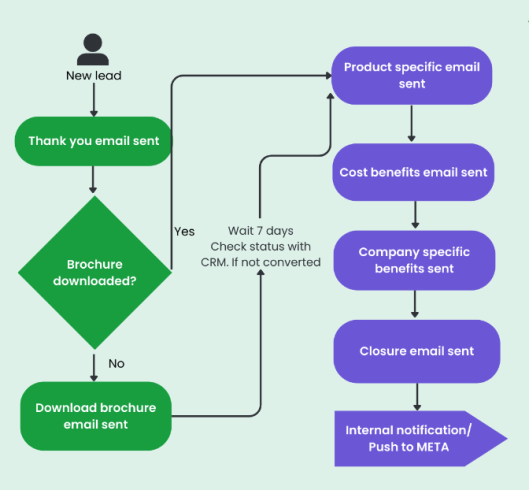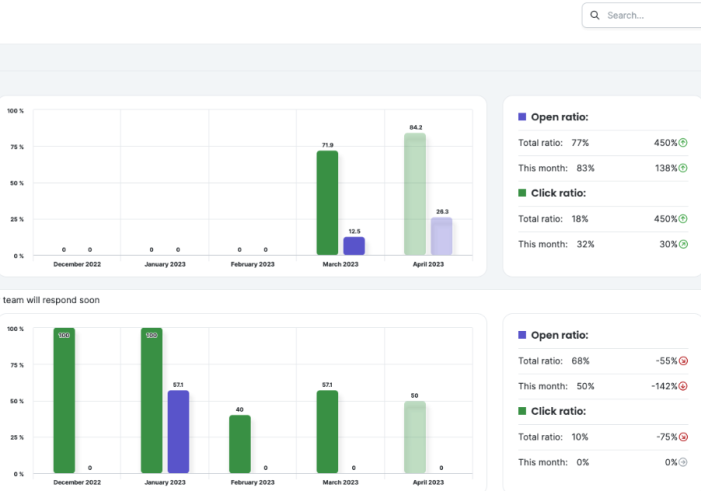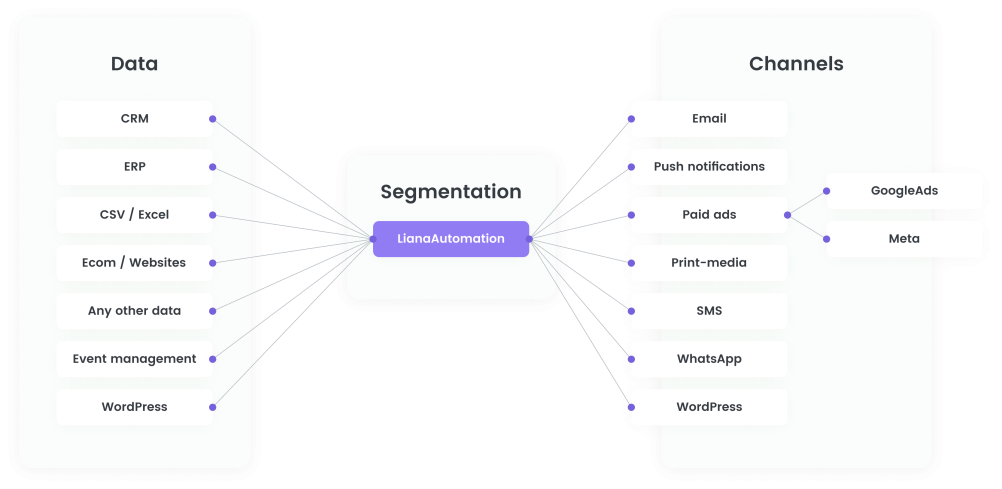By seamlessly connecting data from various sources, businesses can harness the power of automation throughout the buyer journey.
In this article, we delve into the key elements of marketing automation, exploring how you can streamline campaigns, deliver personalized experiences, and achieve remarkable results. We also look into practical strategies for utilizing automation at different stages of the buyer journey.
We will cover the following topics:
1. Marketing automation and data
Don’t let valuable customer data sit in your systems for nothing, take the most out of it instead! With marketing automation, you can pull and push data in and out the platforms you have in use and utilize it efficiently.
How does marketing automation sit in your data ecosystem then? You can collect data for example from your WordPress website, social media channels, CRM or e-commerce platform.
The automation adds the collected data into relevant segments, and these segments are added further to customer journeys, meaning the workflows you have built. Inside those, the automation enables you to send internal notifications (e.g. leads based on different scoring points), send external communications (e.g. email, WhatsApp, push notifications), use outbound channels (paid ads), or add them to mailing lists.
Soon you can also create personalized site views based on the customer data you possess and the segments you have carefully determined in LianaAutomation, which is the exclusive marketing automation tool for WordPress ecosystem and content personalization.
Profile-based segmentation
Personalize the experience of each potential customer with profile-based segmentation. This means that you can classify your prospects based on geographies, areas of interest, timeframes of urgency, etc.
For example, you can create separate audience segments for prospects in Dubai and Abu Dhabi, and market different products and services for each segment. This helps you to evaluate which audience segments perform the best, allocate budgets, and make better business decisions.
Product segmentation with source attribution
In addition to profile-based segmentation, you can also do product-based segmentation with source attributes. When the lead comes in, you can see the source and give different values for them (e.g. CPL, MQL, SQL).
Give different scoring to different channels to make better decisions: for example, you might get MQL’s from Meta but SQL’s from LinkedIn, which can be recognized as a more valuable source. This helps to compare different sources and to decide where to allocate the most budget.
In both segmentation scenarios you can give points for the actions that the identified prospects do through lead nurturing, and set up different activities for the warm and cold leads.
How does CRM fuel automation?
When you integrate your CRM platform and marketing automation, the automation tool will be able to pull different data points from your CRM, such as the name of the customer, birthday, income rate, location, etc. The more data points you can pull from your CRM tool, the more segmentation and personalized communication you can send out to them via marketing automation.
You can also push data into the CRM through marketing automation. They can be any data points related to activities such as browsing on your website, information about the external communications (for example opening a newsletter), how actively they react to your communication, or if they’re added to a segment.
Internally, a notification about a warm lead can be sent to your sales personnel to make them aware of a promising prospect who, for example, almost converted or left an item in their shopping cart.
Catch the leaked traffic from your website
You can also utilize the data collected from your website with marketing automation. With an enhanced script installed, it’s possible to track actions such as scroll data, click data, and the time spent on your website. This gives you the information about which buttons and links were clicked on a specific landing page, or when did the visitor exit the page.
When your webpage has traffic coming in that doesn’t convert – download a guide or subscribe to a newsletter for example – that traffic is lost. With automation, you can utilize the so-called leaked traffic.
For example, when an identified customer visits a certain page, this sends a trigger to your commercial team or marketing team. In the marketing automation tool, you can then see different events with a timestamp, what pages they visited, and what automations it triggered, and you can set different triggers or scoring for those actions.
Soon automation will enable you to personalize your WordPress website content for each visitor with the segments you have created. This will improve website conversions, enhance customer experience, and make your brand stand out.

2. The buyer journey approach
Let’s look at the buyer journey from the audience perspective: awareness, evaluation, purchase decision, and finally being a loyal customer. You can create a marketing automation chain for each stage.
Examples of automations for each stage of the journey
1. Lead nurturing
Here’s an example of lead nurturing automation for the automotive industry. The company wanted to nurture their recent prospects that had shown interest by visiting their web page of new car models, but had not moved to the next stage by, for example, booking a test drive.
At every stage of the automation process, they’re sharing more valuable information about the new car models. The waiting periods are a way to evaluate if the prospect has moved to the next stage: if yes, they would take action. If not, the prospect would go through the workflow and they would be added to the next segment.

2. Remarketing campaign
Let’s look at a newsletter campaign you can use when you want to push your prospects into doing specific actions. Let’s imagine you have offered a brochure to certain prospects. The brochure would include sales material and information about your product.
You can then create two paths based on whether they downloaded the brochure or not. If they did, the automation will then add them to a workflow where you can showcase more product-specific benefits or information. Each stage of the workflow represents a newsletter that will be sent, offering additional services, or services that competitors are not offering.
You can also connect other channels here. For example, remind the prospect about the brochure by sending them an SMS or a WhatsApp message instead of an email.
At the end of the workflow you can send a closure message, where you can give them another opportunity to ask questions or contact you. Internally, you can send a message that this person has completed the workflow and that they now have this information and are a warm lead.
Additionally, you can push the data into paid ad channels and create a custom audience in Meta or Google, where you can then do remarketing.

3. Onboarding automation
Next, we will look into how to keep your existing customers happy by automating onboarding messages. This works especially well when you don’t have account managers or other dedicated personnel for smaller customers or you want to support the onboarding for the bigger accounts. This saves time from multiple teams and a bunch of people – account managers, customer success managers, support team, just to name a few.
First, let the new user feel welcome by sending them a welcome email. You can also offer beneficial material like training videos in different stages of the onboarding process rather than having them live.
Feel free to utilize different channels in the onboarding automation as well: for example, send WhatsApp messages if they’re not reacting to specific emails.

4. Upsell and cross-sell
One of the biggest advantages of marketing automation are the upselling and cross-selling opportunities. Let’s take an example from the hospitality industry.
When a new booking comes in, the customer is added to a new bookings segment. Then after 3 days, they will be offered an upgrade via push notification to a deluxe room, followed by promotion for other popular services the hotel offers one day before arrival: spa services in use, restaurants, etc.
This is important information to get through before the guests actually check in to stay on top of their minds and remind them that you can offer valuable services, potentially encouraging them to make more purchases.
3. Reporting
Now that you are familiar with how to utilize data in marketing automation, let’s take a look at how to interpret the reporting and what kinds of reports are available.
In LianaAutomation, you can get information such as the source of the leads, their status in the lead cycle, a breakdown of sources where the leads were collected from, and detailed campaign breakdowns.
As we know, organizations have different needs and requirements for reporting. With custom integrations, you can build more advanced reports by integrating Pipedrive, Looker Studio, etc. and the automation can push data collected to e.g. funnel.io, and further to PowerBI.
This enables you to get insights of user behavior, how campaigns are performing, where to place your budget, what brings most ROI, etc. If you’d outsource reporting you would get these insights from your account manager on a monthly basis.

Summary
Now you hopefully have a better understanding of what possibilities marketing automation can bring when data is utilized effectively, how the data flows between the platforms and channels, and what concrete use cases look like.
In short, marketing automation can take care of a lot of manual tasks for you, help you get a better understanding of your audience, and help you make better business decisions, just to name a few.
Interested in marketing automation?
Contact our specialists for a tailored demo and get to know how marketing automation can help grow your business.
![Marketing Automation Strategy: Data and the Bigger Picture [With Examples]](https://www.lianatech.com/media/blog/marketing-automation-strategy-article/cache/ma-strategy-article-image-556x313.png)



